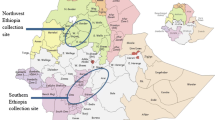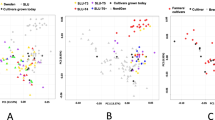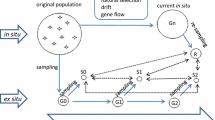Abstract
The germplasm collections of the Vavilov Institute of Plant Industry, Russia represent the first germplasm collection made for potatoes, now numbering 8,680 accessions. It has tremendous historical and practical importance and a rich history, having been used to document a polyploid series in the cultivated species, to formulate initial taxonomic hypotheses in potato, for studies of interspecific hybridization, and serving as the germplasm base for Russian breeding efforts. Despite its importance and size, there has never been a study of its molecular diversity, and there were many gaps in its passport data. The purpose of the present study is to obtain morphological, ploidy, and microsatellite (SSR) data needed to set up a useful subset of the collection of cultivated potatoes and closely related wild species, and to use this collection to study cultivated potato taxonomy and phylogeny. Through assessments of viability, passport data, and chromosome counts, we selected a subset of 238 cultivated and 54 wild accessions. A morphological and nuclear SSR study of these collections distinguished only three cultivated species: Solanum curtilobum, S. juzepczukii and S. tuberosum, not the many more cultivated potato species of prior taxonomic treatments. The SSR study supports the ideas of S. acaule as one of the parental species for S. curtilobum and S. juzepczukii. The morphological and SSR results are very similar to other recent studies of cultivated species, and show the need to reclassify the collection of cultivated potatoes by modern taxonomic criteria.






Similar content being viewed by others
References
Alexanyan SM, Krivchanko VI (1991) Vavilov Institute scientists heroically preserve world plant genetic resources collections during World War II siege of Leningrad. Diversity 7(4):10–13
Bukasov SM (1930) The cultivated plants of Mexico, Guatemala and Colombia. Trudy Prikl Bot Gen Selekcii Suppl 47:191–226, 513–525
Bukasov SM (1933) The potatoes of South America and their breeding possibilities. Trudy Prikl Bot Gen Selekcii 58:1–192
Bukasov SM (1937) Potato breeding. In: Vavilov NI (ed) Theoretical principles of plant breeding, vol 3, pp 3–75
Bukasov SM (1939) The origin of potato species. Physis (Buenos Aires) 18:41–46
Bukasov SM (1955) The system of potato species. In: Zchukovskiy PM (ed) Problems of botany, issue II. Academy of Science USSR press, Moscow-Leningrad, pp 317–326
Bukasov SM (1978) Systematics of the potato. Trudy Prikl Bot Gen Selekcii 62:3–35
Bukasov SM, Kameraz AY (1959) Bases of potato breeding. Gosudaystvennoe Izdatel’sto Sel’skokhozyaistrennoi Literatury, Moscow
Dodds KS (1962) Classification of cultivated potatoes. In: Correll DS (ed) The potato and its wild relatives. Contr Texas Res Found Bot Stud 4:517–539
Dougherty C (2006) London School of Economics. Introduction to econometrics, 3rd edn. University Press, Oxford
Feingold S, Lloyd J, Norero N, Bonierbale M, Lorenzen J (2005) Mapping and characterization of new EST-derived microsatellites for potato (Solanum tuberosum L.). Theor Appl Genet 111:456–466
Fil IV, Novikova LY (2000) The analysis of interaction between crop yield and drought-resistance with morphological and economic characters of self pollinated lines of corn in Krasnodar region by means of statusmetry, vol 239. Nauchno Tekhnicheskiy Bulleten VIR, St. Petersburg, pp 44–46
Ghislain M, Spooner DM, Rodríguez F, Villamon F, Nuñez J, Vásquez C, Waugh R, Bonierbale M (2004) Selection of highly informative and user-friendly microsatellites (SSRs) for genotyping of cultivated potato. Theor Appl Genet 108:881–890
Ghislain M, Andrade D, Rodriguez F, Hijmans RJ, Spooner DM (2006) Genetic analysis of the cultivated potato Solanum tuberosum L. Phureja Group using RAPDs and nuclear SSRs. Theor Appl Genet 113:1515–1527
Ghislain M, Núñez J, del Rosario Herrera M, Pignataro J, Guzman F, Spooner DM (2009) Robust and highly informative microsatellite-based genetic identity kit for potato. Mol Breed 23:377–388
Hawkes JG (1962) The origin of Solanum juzepczukii Buk. and S. curtilobum Juz. et Buk. Zeitsch Pflanzenz 47:1–14
Hawkes JG (1963) A revision of the tuber-bearing Solanums, 2nd edn. Scottish Plant Breeding Station Record 1963, 163 p
Hawkes JG (1990) The potato: evolution, biodiversity and genetic resources. Belhaven Press, Washington
Huamán Z, Spooner DM (2002) Reclassification of landrace populations of cultivated potatoes (Solanum sect. Petota). Am J Bot 89:947–965
Juzepczuk SW (1937) New species of the genus Solanum L. in the group Tuberarium Dun. Bull Acad Sci USSR 2:295–331
Juzepczuk SW, Bukasov SM (1929) A contribution to the question of the origin of the potato. Trudy Vsesoyuzn Szeda Genet Selek 3:593–611
Kardolus JP (1998) A biosystematic analysis of Solanum acaule. Doctoral thesis Wageningen University and Research Center Publications, The Netherlands
Lekhnovich VS (1971) Cultivated potato species. In: Bukasov SM (ed) Flora of cultivated plants, chapter 2, vol IX. Kolos, Leningrad, pp 41–304
Loskutov IG (1999) Vavilov and his institute. A history of the world collection of plant genetic resources in Russia. IPGRI, Rome, 188 p
Milbourne D, Meyer RC, Collins AJ, Ramsay LD, Gebhardt C, Waugh R (1998) Isolation, characterization and mapping of simple sequence repeat loci in potato. Mol Gen Genet 259:233–245
Nei M (1973) Analysis of gene diversity in subdivided populations. Proc Natl Acad Sci USA 70:3321–3323
Raker C, Spooner DM (2002) The Chilean tetraploid cultivated potato, Solanum tuberosum, is distinct from the Andean populations; microsatellite data. Crop Sci 42:1451–1458
Rohlf FJ (1993) NTSYS-pc, Numerical taxonomy and multivariate system. Exeter Publishing, Ltd, New York
Royal Horticultural Society (1986) RHS colour chart. Royal Horticultural Society, London
Rybin VA (1929) Karyological investigation on some wild growing and indigenous cultivated potatoes of America. Trudy Prikl Bot Gen Selekcii 20:655–720 (in Russian)
Rybin VA (1933) Cytological investigation of the South American cultivated and wild potatoes, and its significance for plant breeding. Trudy Prikl Bot Gen Selekcii Ser II 2:3–100
Schmiediche PE, Hawkes JG, Ochoa CM (1980) Breeding of the cultivated potato species Solanum × juzepczukii Buk. and S. × curtilobum Juz. et Buk. I. A study of the natural variation of S. × juzepczukii, S. × curtilobum and their wild progenitor, S. acaule. Bitt. Euphytica 29:685–704
Schmiediche PE, Hawkes JG, Ochoa CM (1982) The breeding of the cultivated potato species Solanum × juzepczukii and S. × curtilobum. II. The resynthesis of S. × juzepczukii and S. × curtilobum. Euphytica 31:395–707
Sokolova EA, Razorenova TS (1996) New information technologies for evaluation of stone fruit plant tolerance to unfavorable environmental conditions depending on their anatomical structure. Problem of fruit plant breeding. Collection of Scientific Articles. Jelgava 222–227
Spooner DM, McLean K, Ramsay G, Waugh R, Bryan GJ (2005) A single domestication for potato based on multilocus AFLP genotyping. Proc Natl Acad Sci USA 102:14694–14699
Spooner DM, Núñez J, Trujillo G, del Rosario Herrera M, Guzmán F, Ghislain M (2007) Extensive simple sequence repeat genotyping of potato landraces supports a major reevaluation of their gene pool structure and classification. Proc Natl Acad Sci USA 104:19398–19403
Tucker AO, Maciarello MJ, Tucker SS (1991) A survey of color charts for biological descriptions. Taxon 40:201–214
Van den Berg RG, Miller JT, Ugarte ML, Kardolus JP, Villand J, Nienhuis J, Spooner DM (1998) Collapse of morphological species in the wild potato Solanum brevicaule complex (sect. Petota). Am J Bot 85:92–109
Vavilov N (1928) Geographische Genzentren unserer Kulturpflanzen. Verhandlungen des V Internationalen Kongresses fur Vererbungswissenschaft, Berlin 1:342–369
Acknowledgments
This study was supported by International Science and Technology Center (ISTC), grant no. 3329, by the ARS/USDA (http://www.vir.nw.ru/biot), and by NSF DEB 0316614 entitled PBI Solanum: A worldwide treatment (http://www.nhm.ac.uk/researchcuration/projects/solanaceaesource//).
Author information
Authors and Affiliations
Corresponding author
Electronic supplementary material
Below is the link to the electronic supplementary material.
Rights and permissions
About this article
Cite this article
Gavrilenko, T., Antonova, O., Ovchinnikova, A. et al. A microsatellite and morphological assessment of the Russian National cultivated potato collection. Genet Resour Crop Evol 57, 1151–1164 (2010). https://doi.org/10.1007/s10722-010-9554-8
Received:
Accepted:
Published:
Issue Date:
DOI: https://doi.org/10.1007/s10722-010-9554-8




